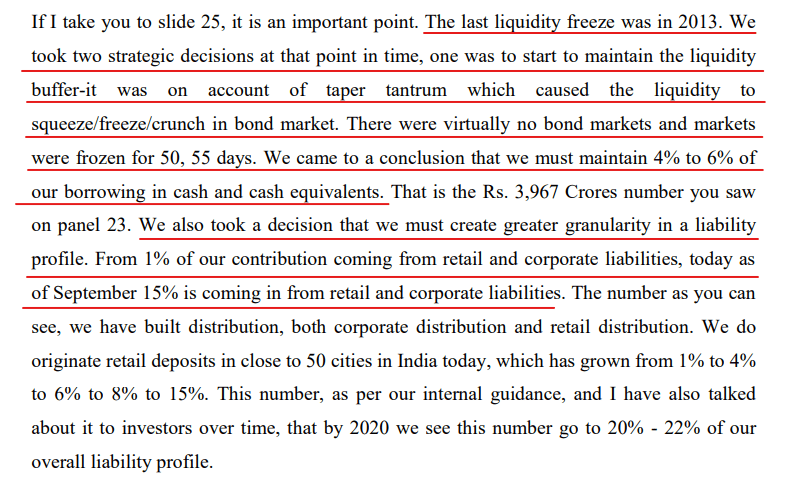I am an investor. And I think of myself as a decision maker. I need to decide what businesses to buy, what not to buy, when to buy, when not to sell and so on. Therefore, the better I get at making decisions the better I get as an investor.
So how do you become a better investor? You become one by using ideas from different fields and not by sticking to just one field. That way, you get different perspectives to the same problem.
There is this famous anecdote. When Berkshire Hathaway was running textile mills, a textile widget salesman came and made a pitch saying his widgets would help Berkshire save money. So Finance-wise it would have been a great buy. But when you think in terms of game theory (an idea from Economics), you see that the cost savings of the widget is not going to be with the textile industry but would instead flow to the customers in the form of lower prices. And so it was likely to become a lousy investment and therefore Munger and Buffett did not invest in the widgets.
So:
- Just Finance: great decision
- Finance + Economics (Game Theory): lousy decision
The point I am trying to make is that by using ideas from different fields, you can probably get different perspectives which is better decision making process.
—
Recently, my son said something like “Everything that you do as an investor relates to commerce and finance; where is the science?” This was clearly a bouncer that I wasn’t expecting. But still I decided to face it rather than duck it. And so I started making a list of ideas from science that I use on a day to day basis. And I thought I would blog about it too.
So the first idea is “Margin of Safety”.
—
Margin of Safety (MoS) is an idea from engineering. I am sure we all use Margin of Safety, knowingly or unknowingly. Yet, it’s better to explain it. Imagine that you build a bridge to a maximum weight of 10,000 Tons. Now what would be the maximum weight of a truck that you would allow on this bridge and why?
- If you say, 10,000 tons, you are wrong.
- The answer would be less (or way less) than 10,000 tons.
Why so? Because you can’t be 100% sure of the weight handling capacity. And therefore you want to allow a room for error. Let’s say that room for error is + or – 5%. That is the bridge can accommodate a weight in the range of 9,500 Tons to 10,500 Tons. But the cost of being wrong can be very high. That is, if you let a truck of weight 10,500 to go through and the bridge collapse due to the weight, then the cost of the damage to property and life could be very, very high. And so, you want to play it safe by allowing a maximum weight of say only 9,000 Tons.
So when I think of Margin of Safety, I don’t think of trucks or bridges. I think of it as a metaphor for some of the following:
- Margin of Safety = Playing it safe
- Margin of Safety = Making room for error
- Margin of Safety = Making room for bad luck
- Margin of Safety = Making room for the unforeseen
- Margin of Safety = Taking out insurance, just in case
And remember Margin of Safety is not free. You have to pay for it either in terms of extra cost or in terms of lower profits than if you didn’t have it. It’s like Life insurance. I don’t plan on dying but I pay my premium anyway.
—
So how do I use Margin of Safety as an investor?
- I always have some money in the bank, just in case tomorrow offers better buying opportunities. Or for some unforeseen liabilities. (A friend of mine who I respect a lot, had invested every Rupee of his and so had to sell a stock just to pay his tax liabilities. That stock, it seems, was waiting to be sold only for it’s price to go up drastically. )
- I buy companies that themselves have sufficient Margin of Safety. (See the example below)
- I never bet everything on one horse. Doing so would be like letting a 10,000 ton truck go on a bridge that can withstand a max of 10,000 tons. Nothing terrible may happen, but I’d rather not count on it. (When I say horses, please think stocks. I don’t even know where the racing track is. )
—
I have written about the Bajaj Finance anecdote before and it’s worth mentioning it again.
In 2013, the US Fed said that they will taper off the Quantitative Easing program. That is, they said we will stop the easy money by raising interest rates. Just this announcement sent shock waves around the world. The Credit markets in India froze for about 50 days. Bajaj Finance faced a cash crunch. They managed to come out of it unscathed. But they took 2 major decisions:
- They will take more borrowings from retail depositors.
- This would cost more, but it would provide an alternate source to the credit markets.
- They will carry surplus liquidity at all times
- This is like saying we will carry spare tire in the car. It will cost us more in fuel expenses but it may come handy when there is a flat tire.
- This is also like how AWS of Google have data center backups. If one goes down, the backup comes live. Yes, the backup was sitting there twiddling thumbs all the while, but it’s there when you need it. Some slack is good.

Bajaj Finance Earnings Call, Oct 2018
So… in a cross country car race, Bajaj Finance decided to take on additional weight of the spare tire. Sure, it costed them but the spare tire came in handy during the rough stretches in 2018 (IL&FS crisis) and again in 2020 (Covid).
—
So, if I look at businesses with Margins of Safety, I also avoid those without Margins of Safety. I had written a blog in Feb 2019 about Vodafone Idea and this is an example of a business whose Interest Outgo is > the Operating Profit. (Imagine a 12,000 T truck on a bridge that can handle only 10,000 Tons. It’s a question of when and not a question of if.) I had in fact even asked Mr. KM Birla to quit this business as it’s going to get worse.
Instead, the promoters – Vodafone and Birla put in an another Rs 25,000 Crs. It was a Losing proposition in 2019; 4 years and 25,000 Crs later, it is still a losing proposition.
25,000 Crs is about $3 Billion, which reminds me of … Thierry Magon de La Villehuchet, who managed a $3 Billion dollar hedge fund. He invested 75% of the fund’s money with Bernie Madoff. When you invest 75% of your fund on one fund, you are not leaving any room for the what-ifs of life. Any risk to Madoff is a risk to you, besides your own risk. When Madoff was arrested for fraud, it wiped out La Villehuchet and he committed suicide shortly.
—
Hope you enjoyed this. I will be talking about a few more ideas in the blogs to come.
-Cheers!
